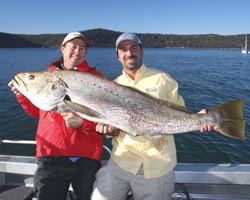 |
| Fishing is depleting stocks of many species at the top of the food chain. |
There's nothing like dropping a line into the ocean and enjoying a spot of recreational fishing on the weekend. However, the popularity of the sport, combined with the thrill of catching fish that put up a strong fight, is depleting stocks of many species at the top of the food chain.
Wild mulloway (Argyrosomus japonicus), or jewfish, are described as apex predators or leviathans of the estuaries. Caught around the river mouths, surf zones and rocky reefs off the shores of Southern Australia, mulloway can grow over 1.5 metres in length and 70 kilograms in weight, meaning they provide an unforgettable catch - and a delicious meal.
As mulloway are also an important commercial catch, larger individuals are being overfished, and there are now serious concerns about its sustainability in NSW estuaries.
The NSW Department of Industry and Investment has responded to this situation by developing a recovery program that will address some of these issues. It has also initiated a mulloway stocking program to enhance recreational fisheries such as the Georges River, south of Sydney, and Smith Lake, on the mid North Coast.
Led by Dr Matthew Taylor from the University of New South Wales, and funded by the NSW Recreational Saltwater Fishing Trust and the Australian Research Council, the stocking program involves the release of hatchery-reared mulloway juveniles (known as fingerlings) and subsequent monitoring.
The project is not just designed to provide additional recreational fishing opportunities, but also to better understand the impacts of releasing mulloway into NSW estuaries, including the impact of stocked fish on the wild population.
The research investigates their food sources (small mysid shrimp, fish and prawns), the fingerlings' behaviour post-release, and the growth rates of the stocked fish.
While the fingerlings released so far have survived to the fishery, the viability of the stocking program will not be assured until scientists have more information about how long it takes the hatchery-reared fingerlings to adapt to wild diet and habitat, and how vulnerable they are to predators in that cycle.
Traditionally this has been achieved by examining the stomach contents of fish. This can be extremely challenging as it relies on visual observations of partially-digested material and only provides an instantaneous 'snapshot' of the diet. Furthermore, not all ingested material is absorbed into the animal's muscle tissue. Other material is assimilated very quickly, meaning that it is rarely found in the stomach.
What's proving to be far more effective and accurate in this study are the carbon and nitrogen stable isotope techniques available at ANSTO.
These stable isotope techniques enable researchers to accurately trace food sources using chemically-validated information.
Dr Taylor recently collaborated with ANSTO environmental scientist, Dr Debashish Mazumder, and compared the unique isotopic signature of the mulloway reared under hatchery conditions with their wild counterparts.
The results provided the team with a mechanism to differentiate stocked fish from wild individuals after recapture, as well as identifying the diet sources of stocked and wild mulloway in the natural environment.
Isotope studies of muscle tissue reveal that mulloway become enriched in both carbon and nitrogen isotopes as they grow in size. The study also found that the isotopic composition of the released fish was distinct from wild fish until 200 days after release, meaning that released fish rapidly adapt to their new diet and surroundings. These findings will aid the design of optimal stocking strategies for mulloway in NSW estuaries.
According to the study, published in the journal, Marine and Freshwater Research, "Stable isotopes are a useful tool for examining the integration of released fish into stocked ecosystems and can be used to describe convergence in the diets of wild and released fish".
Published: 17/06/2010

